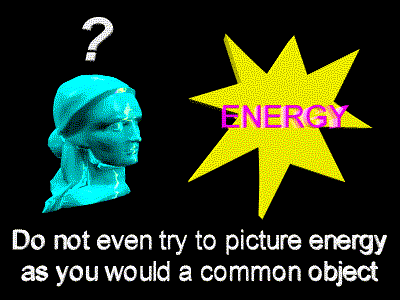Introduction to Energy
Mechanical Energy
For the most part here we will be concerned with the study of mechanical energy. By this we mean that we will be considering the energy concepts associated with everyday, macroscopic, visible objects. We will not be looking at the energy of light waves or energy ideas regarding atoms to any great extent. Those topics are better covered after one has an understanding of mechanical energy and will be presented in the light and atom sections of Zona Land Education.
No Good Energy Pictures
It is very difficult, if not impossible, to visualize energy as an object or anything associated with a shape.

Now, an object, say a baseball, may possess energy, and we can certainly picture that baseball. But the baseball is not the energy. It is best not to see energy in your mind as an object or shape.
Types Of Energy
Energy comes in many forms. There is kinetic energy, the energy of motion. There is potential energy, which is stored energy, or the energy of position. There is more than one type of potential energy. We will be looking at gravitational potential energy and the potential energy of a spring, or elastic potential energy. Here is how all this fits together:
|
So, when an object is moving, it has energy. This form of energy is due to its motion. This form of of motion energy is called kinetic energy.
If you lift an object up, you put energy into the gravitational field. This energy is not immediately apparent. It is stored energy. The higher you lift the object, the more the energy is stored in the gravitational field. So, the amount of energy that is stored is a function of where you locate the object, a function of how high up you lift it. Therefore, potential energy is not only called stored energy, it is also called energy dependent upon position.
After you lift an object and store energy in the gravitational field, how do you get that energy out of storage? You simply drop the object. The energy comes out of storage and becomes the kinetic energy of the now falling object. The farther it falls, the more the energy comes out of storage. This makes the object speed up as it falls and gains more and more kinetic energy as the potential energy comes out of storage. As the object gains more and more kinetic energy, it goes faster and faster. (However, kinetic energy is not directly proportional to speed.)
You can also store energy in a spring. By compressing or stretching a spring you store energy in it. How do you get the energy out of the spring? You release the spring, and it jumps back to its original shape, possibly launching an object as it reshapes. A child's toy dart gun is an example of this. When the dart is put in the gun, a spring compresses; energy is stored in this spring. When the trigger is pulled, the spring is released from its compressed state, and the energy that was stored in it is used to propel the dart. The stored energy in the spring becomes the kinetic energy of the dart.
Basic Definitions
A very good definition of energy is:
Energy is the ability to do work.
And a very good definition of work is:
Work is the transfer of energy.
Now, to understand anything further about energy, one must understand what we mean by the term work in physics. Please progress to the other energy sections to get information on this and other energy topics.